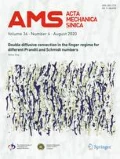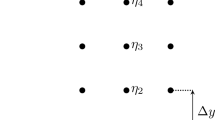Abstract
An efficient high-order numerical method for supersonic reactive flows is proposed in this article. The reactive source term and convection term are solved separately by splitting scheme. In the reaction step, an adaptive time-step method is presented, which can improve the efficiency greatly. In the convection step, a third-order accurate weighted essentially non-oscillatory (WENO) method is adopted to reconstruct the solution in the unstructured grids. Numerical results show that our new method can capture the correct propagation speed of the detonation wave exactly even in coarse grids, while high order accuracy can be achieved in the smooth region. In addition, the proposed adaptive splitting method can reduce the computational cost greatly compared with the traditional splitting method.












Similar content being viewed by others
References
Roy, G.D.: Pulse detonation propulsion: challenges, current status, and future perspective. Prog. Energy Combust. 30, 545–672 (2004)
Geßner, T.: Dynamic mesh adaption for supersonic combustion waves modeled with detailed reaction mechanisms. [Ph.D. Thesis], Technical University Dresden, German (2001)
Fedkiw, R.P., Merriman, B., Osher, S.: High accuracy numerical methods for thermally perfect gas flows with chemistry. J. Comput. Phys. 132, 175–190 (1997)
Togashi, F., Löhner, R., Tsuboi, N.: Numerical simulation of H\(_2\)/air detonation using unstructured mesh. Shock Waves 192, 151–162 (2009)
Ju, Y.: Recent progress and challenges in fundamental combustion research. Adv. Mech. 44, 1142–1157 (2014)
Chapman, D.L.V.I.: On the rate of explosion in gases. Lond. Edinb. Dublin Philos. Mag. J. Sci. 47, 90–104 (1899)
Jouguet, E.: On the propagation of chemical reactions in gases. J. Math. Pureset Appl. 1, 347–425 (1905)
Zeldovich, Y.B.: On the theory of the propagation of detonation in gaseous systems. Tech. Memos. Nat. Adv. Comm. Aeronaut. 1950, 1261 (1950)
Von Neuman, J.: Theory of Detonation Waves. Institute for Advanced Study, Princeton (1942)
Döring, W.: On detonation processes in gases. Ann. Phys. 43, 421–436 (1943)
Bao, W., Jin, S.: The random projection method for hyperbolic conservation laws with stiff reaction terms. J. Comput. Phys. 163, 216–248 (2000)
Bao, W., Jin, S.: The random projection method for stiff detonation capturing. SIAM J. Sci. Comput. 23, 1000–1026 (2001)
Bao, W., Jin, S.: The random projection method for stiff multispecies detonation capturing. J. Comput. Phys. 178, 37–57 (2002)
Helzel, C., Leveque, R.J., Warnecke, G.: A modified fractional step method for the accurate approximation of detonation waves. SIAM J. Sci. Comput. 22, 1489–1510 (2000)
Tosatto, L., Vigevano, L.: Numerical solution of under-resolved detonations. J. Comput. Phys. 227, 2317–2343 (2008)
Dumbser, M., Enaux, C., Toro, E.F.: Finite volume schemes of very high order of accuracy for stiff hyperbolic balance laws. J. Comput. Phys. 227, 3971–4001 (2008)
Wang, W., Shu, C.W., Yee, H.C., et al.: High order finite difference methods with subcell resolution for advection equations with stiff source terms. J. Comput. Phys. 231, 190–214 (2012)
Zhang, B., Liu, H., Chen, F.: The equilibrium state method for hyperbolic conservation laws with stiff reaction terms. J. Comput. Phys. 263, 151–176 (2014)
Taki, S., Fujiwara, T.: Numerical analysis of two-dimensional non-steady detonations. AIAA J. 16, 73–77 (1978)
Lefebvre, M.H., Oran, E.S., Kailasanath, K.: Computations of Detonation Structure: The Influence of Model Input Parameters. Naval Research Lab, Washington, DC (1992)
Sichel, M., Tonello, N.A., Oran, E.S., et al.: A two-step kinetics model for numerical simulation of explosions and detonations in H\(_2\)–O\(_2\) mixtures. R. Soc. 458, 49–82 (2002)
Colella, P., Majda, A., Roytburd, V.: Theoretical and numerical structure for reacting shock waves. SIAM J. Sci. Comput. 7, 1059–1080 (1986)
LeVeque, R.J., Yee, H.C.: A study of numerical methods for hyperbolic conservation laws with stiff source terms. J. Comput. Phys. 86, 187–210 (1990)
Bussing, T.R.A., Murman, E.M.: Finite-volume method for the calculation of compressible chemically reacting flows. AIAA J. 26, 1070–1078 (1988)
Gnoffo, P.A.: An upwind-biased, point-implicit relaxation algorithm for viscous, compressible perfect-gas flows. NASA Tech. Rep. 90, 17–42 (1990)
Zhong X.: New high-order semi-implicit Runge–Kutta schemes for computing transient nonequilibrium hypersonic flow. In: 30th Thermophysics Conference, New York, August 4–14 (1995)
Oran, E.S., Weber, J.W., Stefaniw, E.I., et al.: A numerical study of a two-dimensional H\(_2\)–O\(_2\)–Ar detonation using a detailed chemical reaction model. Combust. Flame 113, 147–163 (1998)
Xiao, X., Edwards, J.R., Hassan, H.A., et al.: Inflow boundary conditions for hybrid large eddy/Reynolds averaged Navier–Stokes simulations. AIAA J. 41, 1481–1489 (2003)
Shen, Y., Zha, G.: Application of low diffusion E-CUSP scheme with high order WENO scheme for chemical reacting flows. In: The 40th Fluid Dynamics Conference and Exhibit, Chicago, June 28–30 (2010)
Taylor, B.D., Kessler, D.A., Gamezo, V.N., et al.: Numerical simulations of hydrogen detonations with detailed chemical kinetics. Proc. Combust. Inst. 34, 2009–2016 (2013)
Billet, G., Ryan, J., Borrel, M.: A Runge Kutta discontinuous Galerkin approach to solve reactive flows on conforming hybrid grids: the parabolic and source operators. Comput. Fluids 95, 98–115 (2014)
Lv, Y., Ihme, M.: Discontinuous Galerkin method for multicomponent chemically reacting flows and combustion. J. Comput. Phys. 270, 105–137 (2014)
Dumbser, M., Castro, M., Parés, C., et al.: ADER schemes on unstructured meshes for non-conservative hyperbolic systems: applications to geophysical flows. Comput. Fluids 38, 1731–1748 (2009)
Dumbser, M., Zanotti, O.: Very high order PNPM schemes on unstructured meshes for the resistive relativistic MHD equations. J. Comput. Phys. 228, 6991–7006 (2009)
Titarev, V.A., Tsoutsanis, P., Drikakis, D.: WENO schemes for mixed-element unstructured meshes. Commun. Comput. Phys. 8, 585–609 (2010)
Zhang, Y.T., Shu, C.W.: Third order WENO scheme on three dimensional tetrahedral meshes. Commun. Comput. Phys. 5, 836–848 (2009)
Zhang, Y., Shu, C.: High-order WENO Sschemes for Hamilton–Jacobi equations on triangular meshes. SIAM J. Sci. Comput. 24, 1005–1030 (2003)
Togashi, F., Löhner, R., Tsuboi, N.: Numerical simulation of H\(_2\)/air detonation using unstructured mesh. Shock Waves 19, 151–162 (2009)
Wang, Z.J.: High-order methods for the Euler and Navier–Stokes equations on unstructured grids. Prog. Aerosp. Sci. 43, 1–41 (2007)
Ekaterinaris, J.A.: High-order accurate, low numerical diffusion methods for aerodynamics. Prog. Aerosp. Sci. 41, 192–300 (2005)
Harten, A., Engquist, B., Osher, S., et al.: Uniformly high order accurate essentially non-oscillatory schemesIII. J. Comput. Phys. 71, 231–303 (1987)
Liu, X.D., Osher, S., Chan, T.: Weighted essentially non-oscillatory schemes. J. Comput. Phys. 115, 200–212 (1994)
Jiang, G.S., Shu, C.W.: Efficient implementation of weighted ENO schemes. J. Comput. Phys. 126, 202–228 (1996)
Cockburn, B., Karniadakis, G.E., Shu, C.W.: The Development of Discontinuous Galerkin Methods. Springer, Berlin (2000)
Wang, Z.J.: Spectral (finite) volume method for conservation laws on unstructured grids basic formulation. J. Comput. Phys. 178, 210–251 (2002)
Zheng, H., Zhao, W.G.: An improved unstructured WENO method for compressible multi-fluids flow. In. J. Numer. Methods Fluids 82, 113–129 (2016)
Stull, D., Prophet, H.: JANAF Thermo Chemical Tables, 2nd edn. NSRDS-NBS37, Washington (1971)
Kailasanath, K., Oran, E.S., Boris, J.P.: Determination of detonation cell size and the role of transverse waves in two-dimensional detonations. Combust. Flame 61, 199–209 (1985)
Hu, Z., Mu, Q., Zhang, D., et al.: Numerical simulation of gaseous detonation wave propagation through bends with a detailed chemical reaction model. Chin. J. Comput. Phys. 21, 408–414 (2004)
Lv, Y., Ihme, M.: Development of discontinuous Galerkin method for detonation and supersonic combustion. In: 51st AIAA Aerospace Sciences Meeting, Grapevine, January 7–10 (2013)
Deiterding, R., Bader, G.: High-Resolution Simulation of Detonations with Detailed Chemistry. In: Analysis and Numeric for Conservation Laws, Berlin Heidelberg, May 4–12 (2005)
Eckett, C.A.: Numerical and Analytical Studies of the Dynamics of Gaseous Detonations [Ph.D. Thesis], California Institute of Technology, America (2000)
Deiterding, R.: Parallel Adaptive Simulation of Multi-Dimensional Detonation Structures. [Ph.D. Thesis], Branderburg University of Technology Cottbus, German (2003)
Li, J., Zhao, Z., Kazakov, A., et al.: An updated comprehensive kinetic model of hydrogen combustion. Int. J. Chem. Kinet. 36, 566–575 (2004)
Stull, D.R., Prophet, H.: JANAF thermo chemical tables. Technical report, U. S. Department of Commerce (1971)
Hu, C., Shu, C.W.: Weighted essentially non-oscillatory schemes on triangular meshes. J. Comput. Phys. 150, 97–127 (1971)
Dumbser, M., Käser, M., Titarev, V.A., et al.: Quadrature-free non-oscillatory finite volume schemes on unstructured meshes for nonlinear hyperbolic systems. J. Comput. Phys. 226, 204–243 (2007)
Ivan, L.: High-order central ENO finite-volume scheme for hyperbolic conservation laws on three-dimensional cubed-sphere grids. J. Comput. Phys. 12, 157–182 (2015)
Ivan, L., Clinton, P.T.: High-order solution-adaptive central essentially non-oscillatory (CENO) method for viscous flows. J. Comput. Phys. 11, 830–862 (2014)
Billet, G., Ryan, J., Borrel, M.: A Runge Kutta discontinuous Galerkin approach to solve reactive flows on conforming hybrid grids: the parabolic and source operators. Comput. Fluids 1, 98–115 (2014)
Billet, G., Ryan, J., Borrel, M.: A Runge Kutta discontinuous Galerkin approach to solve reactive flows on conforming hybrid grids: the parabolic and source operators. Comput. Fluids 23, 98–115 (2014)
Ren, Z.: Dynamic adaptive chemistry with operator splitting schemes for reactive flow simulations. J. Comput. Phys. 263, 19–36 (2014)
Cai, X., Liang, J., Lin, Z., et al.: Adaptive mesh refinement-based numerical simulation of detonation initiation in supersonic combustible mixtures using a hot jet. J. Aerosp. Eng. 28, 1–15 (2015)
Florian, E., Klaus, G., Sattelmayer, T.: Numerical simulation of the deflagration to detonation transition in inhomogeneous mixtures. J. Combust. 31, 1–15 (2014)
Zhou, R., Wu, D., Wang, J.: Progress of continuously rotating detonation engines. Chin. J. Aeronaut. 29, 15–29 (2016)
Qing, Y., Zhang, X.: Discontinuous Galerkin immersed finite element methods for parabolic interface problems. J. Comput. Appl. Math. 1, 127–139 (2016)
Assyr, A., Huber, M.E.: Discontinuous Galerkin finite element heterogeneous multiscale method for advection–diffusion problems with multiplescales. Numer. Math. 126, 589–633 (2014)
Acknowledgements
The project was supported by the National Natural Science Foundation of China (Grants 51476152, 11302213, and 11572336). The authors wish to thank Jun Meng, Li Liu, Jun Peng, Shengping Liu and Guangli Li for helpful discussions. Special thank goes to Prof. Yiqing Shen and Prof. Xinliang Li of the Institute of Mechanics CAS for their suggestions and help.
Author information
Authors and Affiliations
Corresponding authors
Rights and permissions
About this article
Cite this article
Zhao, WG., Zheng, HW., Liu, FJ. et al. An efficient unstructured WENO method for supersonic reactive flows. Acta Mech. Sin. 34, 623–631 (2018). https://doi.org/10.1007/s10409-018-0756-1
Received:
Revised:
Accepted:
Published:
Issue Date:
DOI: https://doi.org/10.1007/s10409-018-0756-1




